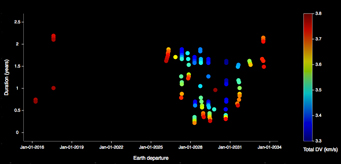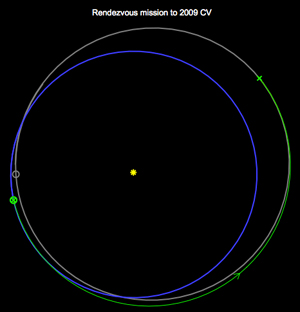A NASA web-based tool plots trajectories to your favorite planet or near-Earth object.
There are lots of reasons to go into space these days. Sure, we could return to the Moon or voyage to Mars, but there are many more targets closer to home — some of them unsettlingly close. Near-Earth objects hold the tantalizing promise of a new, space-based mining industry. And perhaps more importantly for grounded citizens, space travel will likely play a role in diverting potentially hazardous objects.
Designing missions to near-Earth objects (NEOs) just got a little easier. NASA’s tool for preliminary mission planning is now publicly available as the Trajectory Browser. The web-based utility draws from a database of pre-computed trajectories to plot your way from Earth to any planet or known NEO. All you have to do is enter your destination.

NASA
The form gives you the option to limit trajectories based on criteria such as launch window, length of the mission, and the amount of fuel to be burned. Propellant is measured by “DV,” short for delta velocity, which measures how much a rocket needs to accelerate to meet its target. You can also select whether you want the mission to be one-way or roundtrip, rendezvous or flyby.
So far most users are NASA folk, because the site has been used by internal scientists for a while before it went public earlier this month. The site’s creator, Cyrus Foster (NASA Ames), developed the tool to simplify his own work in mission design — the site quickly tells him which targets are accessible when, and how much fuel he’d have to burn to get there. Likewise, for systems engineer Andy Gonzales (NASA Ames), the browser provides quick visualization of different Earth-to-Mars trajectories.

These trajectories to Apophis were calculated for a one-way rendezvous mission, with launches between 2014 and 2036, a minimum duration of 4 years, and a maximum delta velocity (DV) of 7 km/s. There's a ten-year gap (from 2017 to 2027) in available trajectories for these parameters.
NASA
Even as it became clear that the site would be useful for scientists and engineers at other organizations, its value as an educational resource helped push its public release. The site’s ease of use makes it great fun even for newbies like me. I tried my hand at visiting Apophis before its 2036 close approach. The earliest trajectory has a rocket that launches on April 2, 2016 arriving on December 14, 2016. That’s fast, and for relatively little propellant. But there are only a few trajectories available before there’s a 10-year gap.

An April 2, 2016 launch date has the rocket reaching Apophis in 256 days. The diagram shows Earth's orbit (blue) and Apophis's orbit (grey), and the green line shows the path the rocket will take.
NASA
But that brings up an important caveat: this tool is meant for preliminary mission planning only. The browser doesn’t actually calculate trajectories to the destination. Instead, it pulls from a database of trajectories computed ahead of time. To make that massive calculation simpler, Foster imposed limits on which trajectories would be made available — such as not allowing multiple gravity assists, where a rocket slingshots around a planet or a moon to pick up speed. So just because there’s a 10-year gap doesn’t mean we couldn’t get to Apophis between 2017 and 2027, it just means we couldn’t get there simply. The Trajectory Browser’s User Guide lists other limitations.
 1
1
Comments
Anthony Barreiro
March 29, 2013 at 3:41 pm
When I was a child back in the stone age circa 1970, I often visited the Lawrence Berkeley Hall of Science. In the basement there was a computer terminal with the game Moon Lander. You were in command of the Apollo Lunar Excursion Module on its final descent to the lunar surface, travelling at a given speed and trajectory with a certain amount of fuel. You submitted commands to burn fuel and adjust your trajectory with the goal of a soft landing. I always crashed spectacularly, and the game would tell me how large of a crater I created. We've come a long way, but I'm probably still not the best candidate to pilot any spacecraft.
You must be logged in to post a comment.
You must be logged in to post a comment.